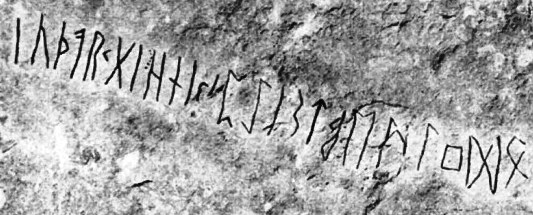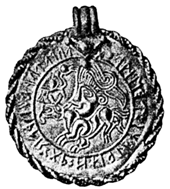Countless “introductions to runes” each represent the Germanic Elder Futhark in a standardized form, both as for the appearance of the individual runes and the order in which they are arranged (my earlier post on the Elder Futhark is no exception). However, we should be aware of the fact that getting the real picture implies the analysis of actual runic inscriptions, not their standardized reproductions. Let us consider the two earliest sequential listings of the Germanic Elder Futhark runes “as is”:
Kylver Stone:

The inscription goes from left to right. Note that f, w and r-runes have no twigs; a, s and b-runes are in a mirror image.
Vadstena Bracteate:

The Futhark inscription begins at 9 and goes to 12 o’clock in the counterclockwise direction (from 12 to 9 o’clock the inscription reads: tuwatuwa). The runes are written from right to left. Note the peculiar form of the p-rune, which looks exactly like b; ï and s-runes are in a mirror image; many runic signs look substantially different as compared to those on the Kylver stone. The last rune is not visible because of the necklace holder, but there is no doubt that it was d-rune (as it appears there on the Mariedamm bracteate, which is almost identical).
Now let us compare the two variants more in detail:
Kylver Stone:

Vadstena Bracteate:

Beside the obvious fact that the inscriptions go in the opposite directions, two more observations should be made: (1) the order of the runes is not the same: groups p-ï and d-o of the Kylver variant go in a reverse order in the Vadstena variant; (2) the Vadstena Futhark is divided into three groups of eight (in Old Norse called ǽttir, ‘families’), beginning with f, h and t-runes. Accordingly, these groups or families of runes were called by the names of Freyr, Hagall and Týr.
Now let us consider the structure of the families on the basis of the rune-order preserved on the Kylver stone (we have to remember that R-rune represents the Common Germanic z):
fuþarkgw-hnijpïzs-tbemlŋdo
A few things are remarkable about these three groups. First of all: each of them contains 2 vowels and 6 consonants. Moreover, the last vowels in each group (a, ï and o) are divided by equal intervals of 9 runes. The number of consonants between the two vowels in each group grows in progression 1-2-4. The number of consonants that go after the last vowel in each group decreases according to the pattern 4-2-0. This is not all: each group has one labial consonant (f, p, b) and a pair of stop consonants, each with an unvoiced and a sonant consonant (k–g; s–z; t–d).
All this shows that the creator of the Elder Futhark had deep insights into the phonological structure of the language for which he designed this form of writing. It is astonishing how elaborate is the inner code of the runic sequence. Whether or not the ancient rune-masters realized the above phonological peculiarities is not clear, but the inscriptions containing the complete Elder Futhark are very numerous. The full set of runes in this order was believed to have supernatural power.
Copyright notice: photos of Kylver Stone and Vadstena Bracteate used in this article are public domain.

In Norway you learn Norse Runes in fifth grade.. I made a clay plate with my name on it :D
That is really cool! I am trying to self teach myself these runes so I can get an accurately translated tattoo. I wonder when you learned the runes in 5th grade you must have had books to learn from. Could you recommend some titles for me?
Manu thanks.
Hello Danver. A couple of titles you may find helpful:
Runes (Reading the Past)

Norwegian Runes and Runic Inscriptions
Hello Ane. That must have been great experience!
Based on a number of runic inscriptions that have been found, it seems that there was no set direction for writing them. You could inscribe them up, down, or backwards and still have the same meaning. Not just the full runic row but for making words and statements, it was the sequence that mattered, not the direction.
Hello Ulfrune. I am not aware of runic inscriptions that would go top-down or bottom-up.
I’ve been researching runes for a very long time now.
They are so fascinating!
I keep pulling Laguz
every day for many days.
is anyone else feeling that something huge is coming. Like water/flow… etc…
I have read many different and conflicting hypothesis when it comes to Runes. (as i’m sure you have) Their history, meanings, stages, definitions, and translations always seem to be just out of reach.
The truth is, it’s mostly conjecture, and we don’t have many facts at all.
I personally don’t think we can “translate” any Runic symbols into Anglo Saxon letters from A-Z. It’s pure guess work.
(of course it’s fun to try)
:) Heather
Hi there, i have found it hard to find books that give facts rather that someone assumption. Without sounding rude would you please be able to point me in the right direction. Thank you
holly
Runes (Reading the Past)

Norwegian Runes and Runic Inscriptions
To be sure, Heather, it’s fun to try :)
Just a passing comment:
I have seen a few examples of where runic writings were done “plowing-the-fields” style, IE: First line Left-to-Right, and then Right-to-Left, in alternating lines. Just thought was very interesting!
I do know that this style of writing was done with some of the Aramaic ( Hebrew ) writings where that style was called “plowing”.
So I don’t think there is any real change of meaning if some of the runes that were written reversed. May have possibly either been to obscure some of it to those unfamiliar with the runes in those times, or to bring particular attention to that section of the writing (???).
On another note:
I would suspect that because wood was much easier to carve into ( being that not all may have had access to the materials for making dedicated chizling tools ), that wood was were you would find the most runic writings. I understand that there were many such “staves” found at various sites. The only problem is, wood easily deteriorates over the centuries – especially in very moist climates.
Might also be interesting to see where rune-users and Ogham users’ territories overlapped. There have been a lot of Oghams found on wooden staves also.
Once again, thanks for the interesting post!
– Rev. Dragon’s Eye
Thanks for the comment. Yes, many ancient scripts were written boustrophedonically.
F UDAR K SI : NSIJ JE PRS : TBE MLNO
W/F = w = as(a gift)
UDAR, dar, darze, obdarować – gift, to give a gift
or (UF DAR = ów dar = this gift)
K – dla = to someone or for someone
SI = si, ten, ta = this (person)
:
NSIJ, nosić, noś = to carry or to wear
JE, ją = it
or(i = and)
PRS = prosz = proszę – please
or (PŻS) = przez = by(carry/wear by you)
:
TBE = ciebie – (by) you
MILNO = miła ma – my love
…………
Lechitic language :)
…………
Please take this gift to wear my love,
..this guy hit the bullseye.
To be sure :)
hmm, very interesting. In Russian(and many other Slavic languages) Dar = gift(modern for ability or offering)(UDAR means strike though), ta = that/she, nosit’/nosish = wear/ing, prosit'(proz’ba) = beg(favor)/please, tebye = to you, milaya = lovely. I don’t know how I ended up on this site but I think he’s right and it’s remarkable how similar it is to modern Russia(maybe not very remarkable since all are based on the Old Slavonic).
The word “udar” is close to the hindi word “udhar” which means gift too. I guess they are somewht related.
Udar (удар) means ‘strike’ in Russian, not ‘gift’.
i am a novice when it come to this stuff but i do have to say i think it change the meaning of the rune inscription upon chancgeing the direction of symbols… if not why whould the rune masters do something so elaborate?
Many archaic alphabets were used in both directions. For instance, ancient Greeks also wrote both from left to right and from right to left.
Perhaps the meaning changes based on direction. Are there any other examples of Elder Futhark being written in both directions?
Fløksand meat knife inscription, Kårstad rock inscription etc. are from right to left.
Dudes so if i wanna write something with runes must i write from RIGHT to LEFT?
Hello. In most cases the answer is yes.
Have you thought about that the Vadstena Bracteate could have been used like a seal ring before it was made into a necklace. Meaning that the script would be left to right once imprinted on wax or clay.
Stonecarver
Hello Stonecarver. Runes on a seal would be concave not embossed.
I’ve seen that line before!
Have you ever stopped and really taken a look at the Kylver Runestone? One of the first things that you notice is the alignment. The first rune is straight and then the line starts to angle with a straightening at the end. Where have I seen that before? As a father of three, and grandfather of three, the answer is on those first few words written by a fledgling writer, on unlined paper! The art of “Staying on Line” is quickly mastered but they leave that crooked line, as a memory of a young students trying, in the heart of the mentor.
This conjures up visions of a young student, wiping tears from his eyes, as he tries to rist (carve) his last proof to a lost mentor, that he has learned his lessons and is a man that will carry on. Can we look at this stone and excuse the errors, as a whisper of a cry of loss, for one who was a beloved mentor. A cry, echoing thru the ages.
HuginOkMunin
this is a phenomenal insight.
Profound and deeply rooted in a personal experience. Thank you, Dean.